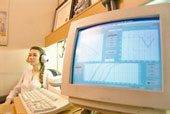- What is audiometry?
- What are the various types of hearing tests?
What is audiometry?
However, with newer and more technology-based audiometry tests, it is now possible to test the patient objectively, i.e., without having to depend on the patients’ assessment.
What are the various types of hearing tests?
First of all is the clinical assessment of hearing: this is by the tuning fork tests: Rinne and weber test. A tuning fork (a two pronged resonating instrument which produces a sound when struck) is used next to the ear (AIR Conduction).
Then is applied on the bone behind the ear. Comparing the two, and how long the sound can be heard, gives an assessment of the extent, and type of hearing loss- conductive hearing loss, due to a problem in the middle ear, or sensory neural hearing loss, due to a problem in the inner ear or the nerves. It can also pick up malingering. (Acting).
Basic speech audiometry is also a clinical assessment, where the examiner says words standing six feet behind the patient, or whispers words 2 feet away and gets a subjective assessment of the hearing loss. There are three main types of audiometrical procedures:
- Pure tone audiometry
- Speech audiometry
- Immittance audiometry
- Evoked response Audiometry
Pure tone audiometry: This procedure uses an audiometer (an instrument for recording the intensity of sound heard by the patient) to determine the extent of hearing loss. The patient is made to hear pure tones (musical or non-musical) of varying frequencies and intensities.
There may be high-pitched sounds played at frequent intervals and the patients response to these are noted. The site of hearing loss can also be determined by the readings on the audiogram. They are given by air conduction by an earmuff, and by a probe put on the bone behind the ear.
The patient is seated in a quiet testing chamber and made to wear earphones. Each ear is tested separately. The sounds begin with the lowest frequency that is increased till the person is able to hear the sound. The patient indicates as such by raising a hand, and the audiometer reading is noted.
The examiner asks the patient to repeat whatever is said to him and then determines the extent and area of hearing loss. Unlike the clinical speech- hearing assessment, a definite number of words, for a set protocol are used, and the percentage of words understood is noted, and the lowest intensity to understand a set percentage is noted. This helps in differentiating between hearing loss caused due to damage in the hearing organ, and the hearing nerve.
The movement of the eardrum in response to pressure changes is measured but the reflection of the sound waves from the drum. In a patient with hearing loss due to malformation of the eardrum or the ossicles, (the three small bones which work as a lever mechanism), or fluid in the middle ear, these sound waves are reflected back abnormally, and are measured by the special audiometer called the electro-acoustic immittance bridge (Impedance audiometer).
Electric Response Audiometer (ERA): Is an instrument to measure the hearing power of a child soon after birth. It measures the normal electrical signals given out by a normal inner ear and is the most painless and non- invasive method to assess that a newborn child has normal or near-normal hearing.



